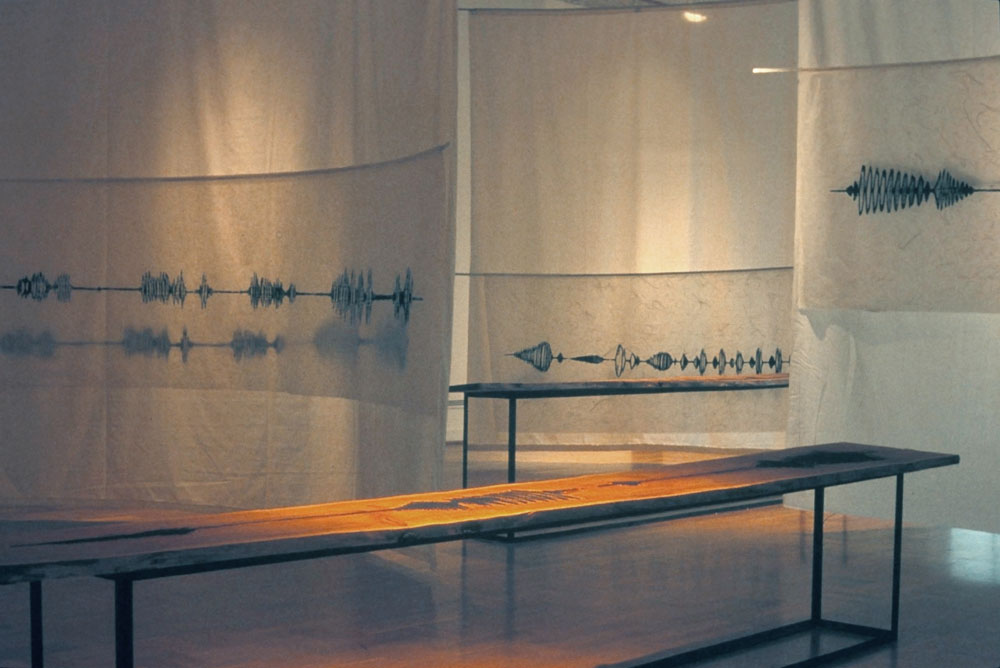Recording Bird Songs
WORK IN EXHIBITION
RECORDING BIRD SONGS INSTALLATION
4 fir woodblock carved with bird calls, Robin, Redwing Black Bird, Song Sparrow, and Swallow Woodblocks, 10’ x 12”, 12 Woodblock prints on Hosha rice paper 36" x 10' 6 linen spaces supported by aluminum flat stock, 8' x 12' 4-hour digital recording of the birds played continuously in the installation
ARTIST’S STATEMENT
"...so we shall be supplied with visual and auditory images which will appear and disappear at a simple movement of the hand, hardly more than a sign.1 (citation)
I often lie awake at 4 a.m. waiting for sleep to return. When the birds begin to sing, I get up. I am amazed at how the world looks on that side of the night. The dim light and moist air soften all the edges. The only sound is the birds. They begin slowly. One gives a call and then the others awaken until there is a cacophony. In early spring the finches are the first to awaken, in May it is the robins, in later summer the song sparrows. I began to listen to the birds this year so I could learn to identify each of their calls.
I recorded them beginning at 4 a.m. through to 7 a.m. so there would be very little noise. I found in researching the subject that ornithologists have been using sound recording devices to chart and study the patterns of the songs since the late 1940's. Oscillograms are visually quite beautiful. The oscillogram is a recording drum used for sonogram writing. Bell Lab first introduced this equipment in 1946 to make speech visible. The result, when used for a bird song, is a rhythmic pattern of lines that mimic the harmonic sound.
I began to make my own sound recordings of birds this summer. The calls that dominate the recording are the robin, the song sparrow, the swallow, and the red-winged black bird. For the visual component of the exhibition, I used the oscillograms from each of these birdcalls. I enlarged and transferred these images on to 9' milled planks of fir and carved them in relief so to make large wood cut prints.
I chose to carve the graphic formation of sound on to wood block because it is the first medium used for text and image reproduction. The history of the relief printing process is the history of people's desire to communicate and duplicate information. Early wood block stamps date to 6th Century Egypt and China. The invention of paper in China in 107 BC opened up the possibility of multiple printing and the dissemination of images and information. The influence of printed matter, recorded sound, and image has an enormous impact on our lives. We record and store temporal events constantly. This translation has become the replacement for the actual experience. Recordings of birds are additionally ironic because they repeat themselves over and over with subtle variations. Although one can single out and identify the rhythmic call of each bird in a sound recording, the actual timing and layering of the song that occurred at any given moment can never really be duplicated.
I am mimicking the multiplicity of the songs by installing layers of curved transparent printed screens throughout the gallery. The blocks with the carved pattern are on long steel benches at various heights to mimic the dominance of each birdcall. The entire space is filled with the sound recording. It is my hope that the viewer becomes lost in a maze of screens and sounds.
I am intrigued by making the invisible visible, if only temporarily.
This exhibition could not have been possible without the help of my students Jeremy Wingfield and Donna White. Jeremy helped me to transfer images, carve the fir board and weld the stands. Donna helped transfer images, sewed all the linen, and assisted me in printing. I cannot thank them enough for their dedication, skill, and insight.
- Paul Valery, Aesthetics, The Conquest of Ubiquity p.226. Translated by Ralph Manheim. As quoted in, Walter Benjamin, Illumination Walter Benjamin Essays and Reflections, The Work of Art in the Age of Mechanical Reproduction, (p.219)
"Just as lithography virtually implied the illustrated newspaper, so did photography foreshadow the sound film. The technical reproduction of sound was tackled at the end of the lst Century. These convergent endeavors made predictable a situation which Paul Valery pointed up in this sentence: 'Just as water, gas and electric are brought into our houses from far off to satisfy our needs in response to a minimal effort, so we shall be supplied with visual or auditory images which will appear and disappear at a simple movement of the hand, hardly more than a sign' (op. cit., p. 226).

